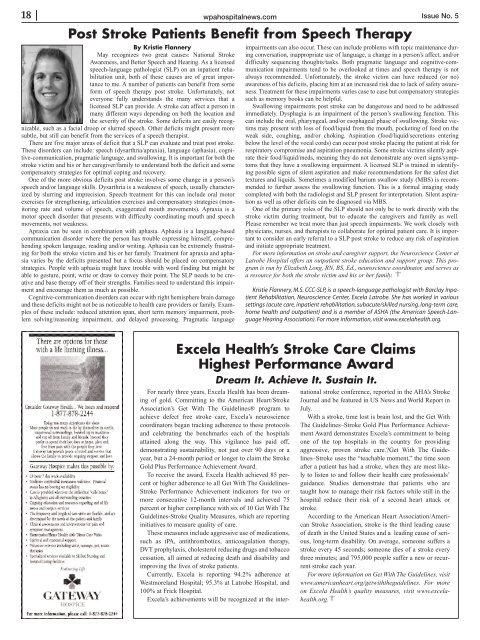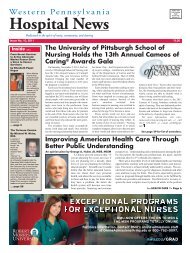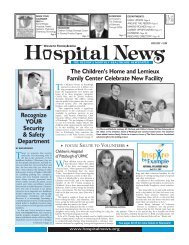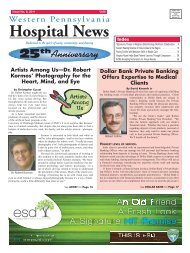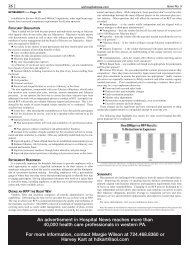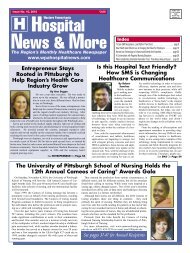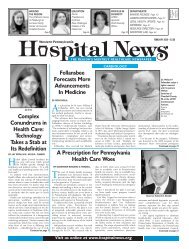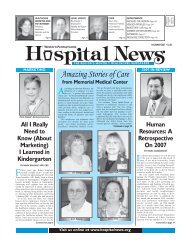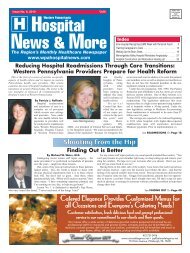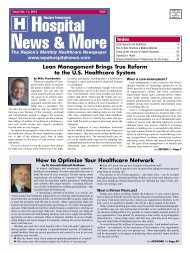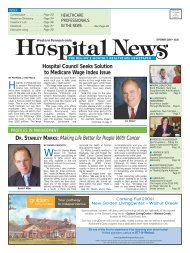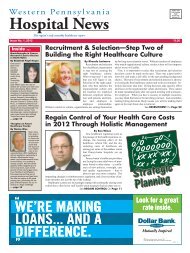McKeesport Hospital Foundation holds 33rd annual Invitational ...
McKeesport Hospital Foundation holds 33rd annual Invitational ...
McKeesport Hospital Foundation holds 33rd annual Invitational ...
You also want an ePaper? Increase the reach of your titles
YUMPU automatically turns print PDFs into web optimized ePapers that Google loves.
18 | Issue No. 5wpahospitalnews.comPost Stroke Patients Benefit from Speech TherapyBy Kristie FlanneryMay recognizes two great causes: National StrokeAwareness, and Better Speech and Hearing. As a licensedspeech-language pathologist (SLP) on an inpatient rehabilitationunit, both of these causes are of great importanceto me. A number of patients can benefit from someform of speech therapy post stroke. Unfortunately, noteveryone fully understands the many services that alicensed SLP can provide. A stroke can affect a person inmany different ways depending on both the location andthe severity of the stroke. Some deficits are easily recognizable,such as a facial droop or slurred speech. Other deficits might present moresubtle, but still can benefit from the services of a speech therapist.There are five major areas of deficit that a SLP can evaluate and treat post stroke.These disorders can include: speech (dysarthria/apraxia), language (aphasia), cognitive-communication,pragmatic language, and swallowing. It is important for both thestroke victim and his or her caregiver/family to understand both the deficit and somecompensatory strategies for optimal coping and recovery.One of the more obvious deficits post stroke involves some change in a person’sspeech and/or language skills. Dysarthria is a weakness of speech, usually characterizedby slurring and imprecision. Speech treatment for this can include oral motorexercises for strengthening, articulation exercises and compensatory strategies (monitoringrate and volume of speech, exaggerated mouth movements). Apraxia is amotor speech disorder that presents with difficulty coordinating mouth and speechmovements, not weakness.Apraxia can be seen in combination with aphasia. Aphasia is a language-basedcommunication disorder where the person has trouble expressing himself, comprehendingspoken language, reading and/or writing. Aphasia can be extremely frustratingfor both the stroke victim and his or her family. Treatment for apraxia and aphasiavaries by the deficits presented but a focus should be placed on compensatorystrategies. People with aphasia might have trouble with word finding but might beable to gesture, point, write or draw to convey their point. The SLP needs to be creativeand base therapy off of their strengths. Families need to understand this impairmentand encourage them as much as possible.Cognitive-communication disorders can occur with right hemisphere brain damageand these deficits might not be as noticeable to health care providers or family. Examplesof these include: reduced attention span, short term memory impairment, problemsolving/reasoning impairment, and delayed processing. Pragmatic languageimpairments can also occur. These can include problems with topic maintenance duringconversation, inappropriate use of language, a change in a person’s affect, and/ordifficulty sequencing thoughts/tasks. Both pragmatic language and cognitive-communicationimpairments tend to be overlooked at times and speech therapy is notalways recommended. Unfortunately, the stroke victim can have reduced (or no)awareness of his deficits, placing him at an increased risk due to lack of safety awareness.Treatment for these impairments varies case to case but compensatory strategiessuch as memory books can be helpful.Swallowing impairments post stroke can be dangerous and need to be addressedimmediately. Dysphagia is an impairment of the person’s swallowing function. Thiscan include the oral, pharyngeal, and/or esophageal phase of swallowing. Stroke victimsmay present with loss of food/liquid from the mouth, pocketing of food on theweak side, coughing, and/or choking. Aspiration (food/liquid/secretions enteringbelow the level of the vocal cords) can occur post stroke placing the patient at risk forrespiratory compromise and aspiration pneumonia. Some stroke victims silently aspiratetheir food/liquid/meds, meaning they do not demonstrate any overt signs/symptomsthat they have a swallowing impairment. A licensed SLP is trained in identifyingpossible signs of silent aspiration and make recommendations for the safest diettextures and liquids. Sometimes a modified barium swallow study (MBS) is recommendedto further assess the swallowing function. This is a formal imaging studycompleted with both the radiologist and SLP present for interpretation. Silent aspirationas well as other deficits can be diagnosed via MBS.One of the primary roles of the SLP should not only be to work directly with thestroke victim during treatment, but to educate the caregivers and family as well.Please remember we treat more than just speech impairments. We work closely withphysicians, nurses, and therapists to collaborate for optimal patient care. It is importantto consider an early referral to a SLP post stroke to reduce any risk of aspirationand initiate appropriate treatment.For more information on stroke and caregiver support, the Neuroscience Center atLatrobe <strong>Hospital</strong> offers an outpatient stroke education and support group. This programis run by Elizabeth Long, RN, BS, Ed., neuroscience coordinator, and serves asa resource for both the stroke victim and his or her family.Kristie Flannery, M.S. CCC-SLP, is a speech-language pathologist with Barclay InpatientRehabilitation, Neuroscience Center, Excela Latrobe. She has worked in varioussettings (acute care, inpatient rehabilitation, subacute/skilled nursing, long-term care,home health and outpatient) and is a member of ASHA (the American Speech-LanguageHearing Association). For more information, visit www.excelahealth.org.Excela Health’s Stroke Care ClaimsHighest Performance AwardDream It. Achieve It. Sustain It.For nearly three years, Excela Health has been dreamingof gold. Committing to the American Heart/StrokeAssociation’s Get With The Guidelines® program toachieve defect free stroke care, Excela’s neurosciencecoordinators began tracking adherence to these protocolsand celebrating the benchmarks each of the hospitalsattained along the way. This vigilance has paid off,demonstrating sustainability, not just over 90 days or ayear, but a 24-month period or longer to claim the StrokeGold Plus Performance Achievement Award.To receive the award, Excela Health achieved 85 percentor higher adherence to all Get With The Guidelines-Stroke Performance Achievement indicators for two ormore consecutive 12-month intervals and achieved 75percent or higher compliance with six of 10 Get With TheGuidelines-Stroke Quality Measures, which are reportinginitiatives to measure quality of care.These measures include aggressive use of medications,such as tPA, antithrombotics, anticoagulation therapy,DVT prophylaxis, cholesterol reducing drugs and tobaccocessation, all aimed at reducing death and disability andimproving the lives of stroke patients.Currently, Excela is reporting 94.2% adherence atWestmoreland <strong>Hospital</strong>; 95.3% at Latrobe <strong>Hospital</strong>, and100% at Frick <strong>Hospital</strong>.Excela’s achievements will be recognized at the internationalstroke conference, reported in the AHA’s StrokeJournal and be featured in US News and World Report inJuly.With a stroke, time lost is brain lost, and the Get WithThe Guidelines–Stroke Gold Plus Performance AchievementAward demonstrates Excela’s commitment to beingone of the top hospitals in the country for providingaggressive, proven stroke care.?Get With The Guidelines–Strokeuses the “teachable moment,” the time soonafter a patient has had a stroke, when they are most likelyto listen to and follow their health care professionals’guidance. Studies demonstrate that patients who aretaught how to manage their risk factors while still in thehospital reduce their risk of a second heart attack orstroke.According to the American Heart Association/AmericanStroke Association, stroke is the third leading causeof death in the United States and a leading cause of serious,long-term disability. On average, someone suffers astroke every 45 seconds; someone dies of a stroke everythree minutes; and 795,000 people suffer a new or recurrentstroke each year.For more information on Get With The Guidelines, visitwww.americanheart.org/getwiththeguidelines. For moreon Excela Health’s quality measures, visit www.excelahealth.org.


